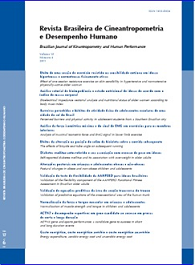Energy expenditure, aerobic energy cost and anaerobic energy cost.
DOI:
https://doi.org/10.1590/1980-0037.2011v13n6p484Abstract
The difficulty involved in the calculation of the energy cost during most of the physical activities is related to the mixed nature of the energy elicited. Therefore, it is important to know under which exercise condition it is possible to perform such measurements and under which conditions it is not. Several terms are often associated with this line of research, such as: energy expenditure, caloric expenditure or energy cost. The aim of the current paper was to remind the methods that are typically used to assess energy cost and to propose a more precise nomenclature when teaching or researching under these thematic. The use of expired O2 to quantify aerobic energy seems undisputable. As to anaerobic lactic energy, more studies are required, using both the blood lactate energy equivalent and the accumulated oxygen deficit. The term “energy expenditure” should be used only when energy release is almost fully aerobic and when direct O2 measurement can be performed during exercise. In every other conditions of exercise, the term “energy cost” is more suitable, as it cannot be directly assessed. Whenever “energy cost” is referred, it should be accompanied by the identification of whether aerobic fraction, anaerobic fraction or total energy cost is considered.



